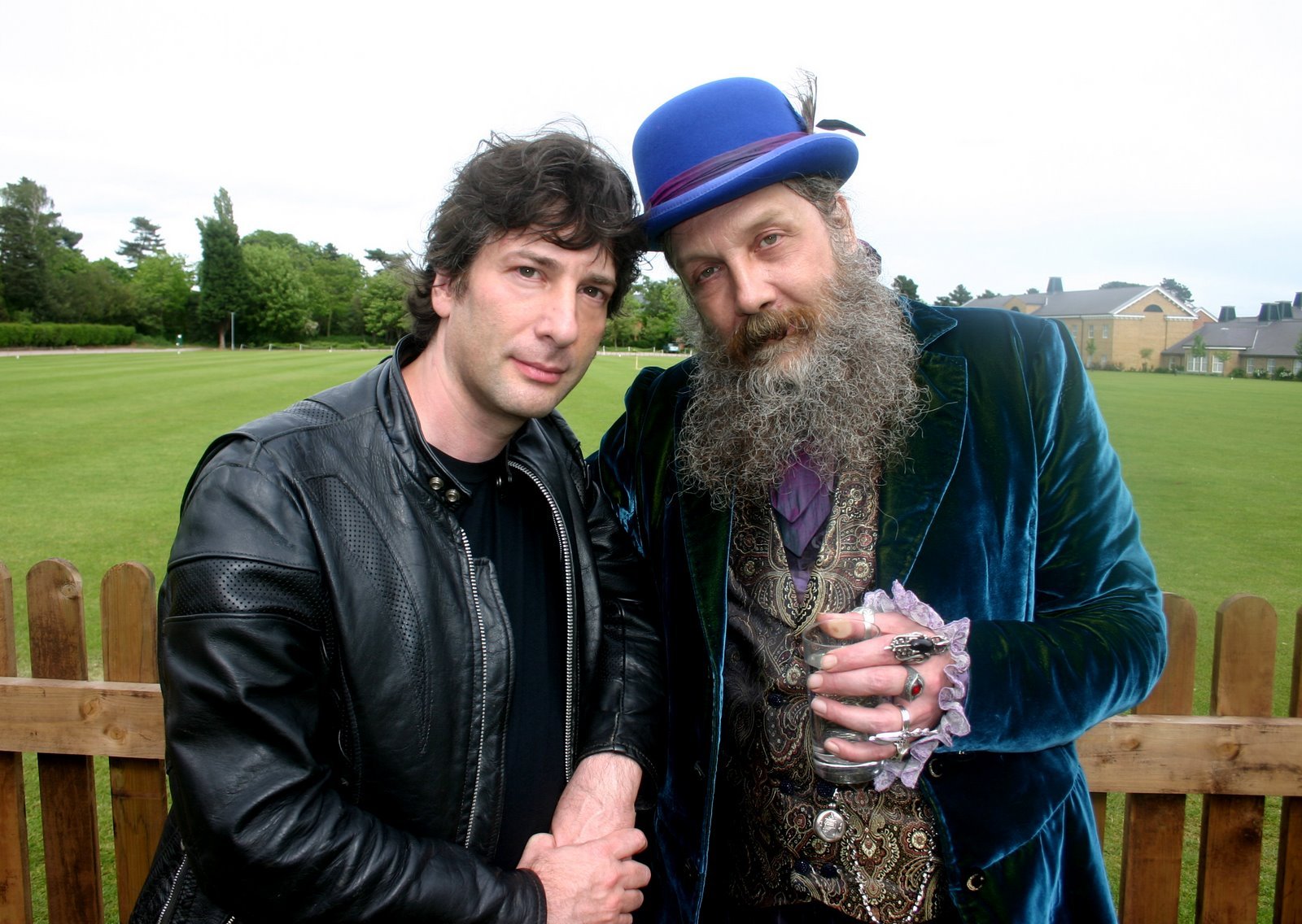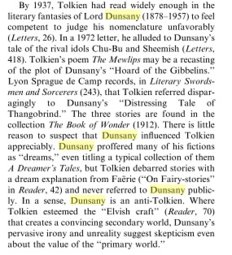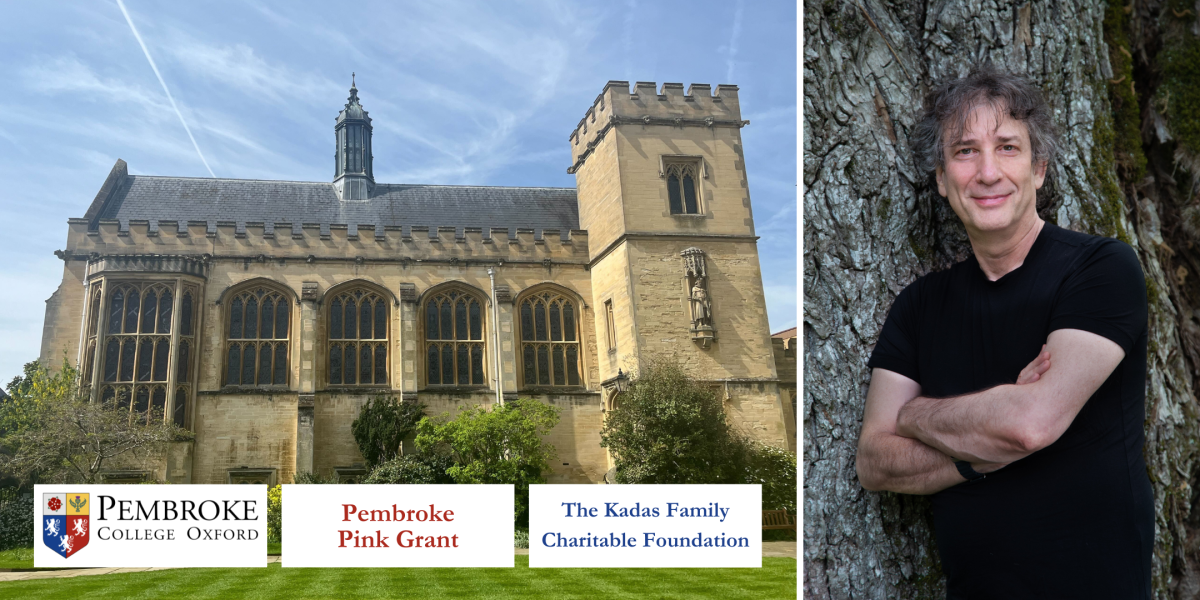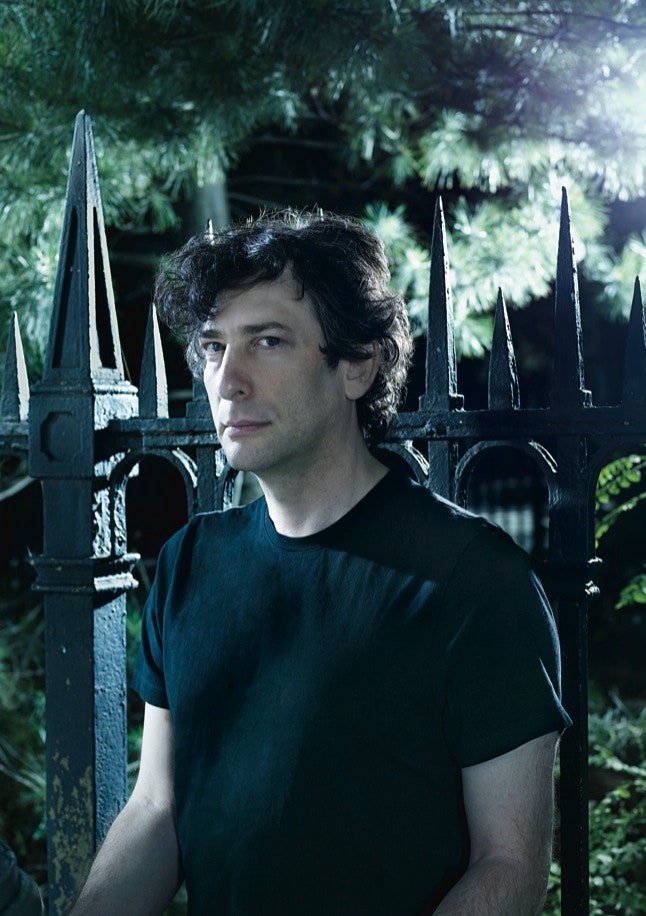Kid Goth
Neil Gaiman’s fantasies.
By
Dana Goodyear
January 17, 2010
Gaiman’s “Coraline” was first thought too frightening for children. Now, he says, it’s a “beloved text.”Photograph by Eric Ogden
In “The New Mother,” a children’s story published by Lucy Clifford in 1882, two previously well-behaved little girls turn so bad—dousing the fire and breaking the clock and dancing on the butter—that their mother is forced to go away, and a new mother, a demon with two glass eyes and a horrible wooden tail, comes to take her place. At the story’s end, the girls flee to the forest to live; they miss their mother terribly and long in vain for the chance to redeem themselves. Sometimes, at night, they sneak back to their old cottage, where through the window they can see the glint of the new mother’s glass eyes.
Gothic horror was thoroughly out of fashion in children’s literature when, in the early nineteen-nineties, the writer Neil Gaiman began to work on “Coraline,” a book aimed at “middle readers”—aged nine to twelve—in which he reimagined Clifford’s demon as “the other mother,” an evil and cunning anti-creator who threatens to destroy his young protagonist. “The idea was, look, if the Victorians can do something that deeply unsettles kids, I should be able to do that, too,” he told me recently.
Gaiman, who is forty-nine and English, with a pale face and a wild, corkscrewed mop of black-and-gray hair, is unusually prolific. In addition to horror, he writes fantasy, fairy tales, science fiction, and apocalyptic romps, in the form of novels, comics, picture books, short stories, poems, and screenplays. Now and then, he writes a song. Gaiman’s books are genre pieces that refuse to remain true to their genres, and his audience is broader than any purist’s: he defines his readership as “bipeds.” His mode is syncretic, with sources ranging from English folktales to glam rock and the Midrash, and enchantment is his major theme: life as we know it, only prone to visitations by Norse gods, trolls, Arthurian knights, and kindergarten-age zombies. “Neil’s writing is kind of fey in the best sense of the word,” the comic-book writer Alan Moore told me. “His best effects come out of people or characters or situations in the real world being starkly juxtaposed with this misty fantasy world.” The model for Gaiman’s eclecticism is G. K. Chesterton; his work, Gaiman says, “left me with an idea of London as this wonderful, mythical, magical place, which became the way I saw the world.” Chesterton’s career also serves as a warning. “He would have been a better writer if he’d written less,” Gaiman says. “There’s always that fear of writing too much if you’re a reasonably facile writer, and I’m a reasonably facile writer.”
Gaiman’s two most recent novels, “Anansi Boys” (2005) and “The Graveyard Book” (2008)—a retelling of Rudyard Kipling’s “The Jungle Book,” set in a graveyard—débuted at No. 1 on the New York
Times best-seller list in their respective categories, adult and children’s literature. Yet Gaiman remains somewhat marginal. The
Times of London recently referred to him as “the most famous writer you’ve never heard of.” The New York
Times waited to review “The Graveyard Book” for several months after its publication, by which time it had won the 2009 Newbery Medal, one of the highest honors in children’s fiction, and been on the best-seller list for eighteen weeks. “I have at this point a critic-proof career,” Gaiman said. “The fans already knew about the book.”
The title character of “Coraline” is an inquisitive girl with distracted parents, living in an old house with a bricked-up door in one of its rooms. One day, she tests the door and finds that it opens onto a passageway. As with Alice’s rabbit hole and Lucy Pevensie’s closet full of furs, at the other end is an alternate world: in this case, a house that is an idealized replica of Coraline’s own, presided over by the other mother, who, Gaiman writes, resembles her real one— “Only her skin was as white as paper. Only she was taller and thinner. Only her fingers were too long, and they never stopped moving, and her dark red fingernails were curved and sharp.” In place of eyes, she has two black buttons. She entreats Coraline to stay, plying her with delicious food (her own mother cooks from packets) and magical toys. But the other mother’s world is an illusion and a trap; what she really wants is to take Coraline’s eyes and replace them with buttons.
Unlike its literary progenitor, “Coraline” resolves comfortingly: the heroine outsmarts the other mother and escapes; in the process, she saves the souls of three ghost children—earlier victims—and frees her parents, who have also been drawn into the plot. At home, the last night of summer vacation, Coraline drifts into a peaceful sleep, realizing “there was nothing left about school that could scare her anymore.”
In Gaiman, the horror is domesticated and made hygienic for contemporary tastes. Even so, when he showed an early draft to an editor in 1991, he was told it was unpublishable: far too frightening for kids. (Gaiman maintains that adults are more afraid of “Coraline” than children are.) The novel finally came out in 2002. Last year, a movie version was released, directed by Henry Selick in 3-D stop-motion animation, with Teri Hatcher playing both mothers and Dakota Fanning as Coraline. It won a Children’s
BAFTA and has been nominated for a Golden Globe. The book has spent a total of seventeen weeks on the best-seller list, and is now, Gaiman says, a “beloved text.”
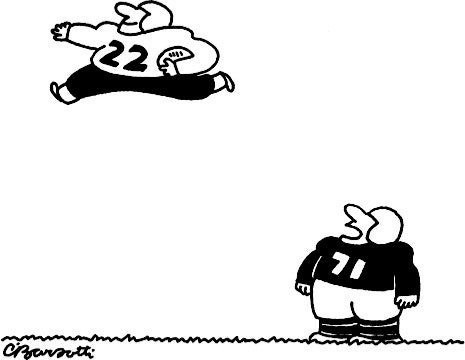
“You mock, sir—you mock a sport storied and beloved. I, sir, pity you.”
Link copied
In the world of science fiction and fantasy, the boundary between writers and readers is highly permeable. Arthur C. Clarke used to go to conventions wearing a loud Hawaiian shirt—an emblem of sci-fi fandom—and mingle with the crowds. Gaiman has adapted that relationship for the age of social media. He was one of the first writers to have a blog—he started it in 2001, and had, at last count, some 1.4 million readers—and he often posts to his Twitter feed a dozen or more times a day. He attributes his recent No. 1 débuts to his ability to communicate directly with his fans: he tells them to buy a book on a certain day, and they do. “It means I’m nobody’s bitch,” he told me. Through the blog and Twitter, readers have a seemingly transparent window into his process. “Writing Metamorpho. Trying to decide if broccoli is funnier than kohlrabi in a list of vegetables,” he tweeted several months ago, when he was working on a new comic. His next post on the subject read, “So far the broccoli/kohlrabi votes are pretty much evenly split. Although several of you think ‘rutabaga’ is funnier than either.” Eleven minutes later, he posted again: “(Okay. The line now reads) Java: ‘Java dreams of giant vegetables. Chiefly rutabaga and unusually knobbly turnips. But not broccoli.’ ”
To his readers, Gaiman projects an image that is at once iconic author-hero and cozy bookworm. “At the age of four, I was bit by a radioactive awesome,” he’ll say, by way of the origin story that comics fans are conditioned to expect. Sartorially, he is remarkably like Dream, who is one of his best-loved characters and the protagonist of a monthly series called “The Sandman,” which he wrote for DC Comics between 1988 and 1996. He wears black: black socks, black jeans, black T-shirts, black boots, and black jackets whose pockets are loaded with small black notebooks and pots of fountain-pen ink in shades like raven. Pictures of his book collection, which contains some five thousand volumes, circulate on the Internet, propagating brainy crushes: “How could I not fall for this guy??? Honestly . . . look at the sheer size of his . . .
library!”
“Of course, he wants to become a character,” Stephin Merritt, who is the lead singer of the Magnetic Fields and a friend of Gaiman, says. “He’s not Salvador Dali, but he’s not far off. There’s no hard line between his persona and his private life.” Jon Levin, Gaiman’s film agent, says he recognized his client’s popularity only when he took him to a meeting at Warner Bros. and all the secretaries got up from their desks to ask for autographs. Someone said, “That never happens when Tom Cruise is here.”
Video From The New Yorker
An Iranian Woman Finds Her Might, in “The Smallest Power”
Several months ago, Gaiman was in New York for a few days and gave a reading at the Housing Works bookstore, downtown. It was a joint appearance with Amanda Palmer, a musician from the punk-cabaret act the Dresden Dolls, who was Gaiman’s girlfriend at the time. (They are now engaged to be married. He proposed on New Year’s Day, drawing a ring on her finger with a Sharpie.) The couple met in 2008, when Palmer was working on a solo album and asked Gaiman, to whom she was introduced by a mutual friend, to write stories to accompany photographs of her as a corpse. That afternoon in New York, they had been interviewed in the bath: she naked, he wearing a suit jacket that had been bought for forty bucks from a drunk in Tompkins Square Park.
Everywhere Gaiman goes, he encounters women dressed as Death, Dream’s sister in “Sandman”: black clothing, elaborate black eye makeup, and, often, an ankh charm around the neck. (Internet critics deride Gaiman’s fans as “Twee ‘Bisexual’ Goth Girls with BPD”—borderline personality disorder—“who are drama majors and who are destined to become cat ladies.”) Inside Housing Works, there was a great deal of black and much Gaiman-inspired tattoo art. A middle-aged man wore a T-shirt printed with the text of one of Gaiman’s tweets: “Honestly, if you’re given the choice between Armageddon or tea, you don’t say ‘What kind of tea?’ ”
At a little past eight, Palmer appeared onstage, wearing a military jacket and a tartan miniskirt, and sat down at a keyboard; Gaiman stood at a microphone. Images of Palmer—mostly naked, bloody, battered, drowned, or morosely propped up at a dinner table—were projected on the wall behind them. Gaiman began to read in a voice that was deep and singsongy and richly theatrical, with a double edge of menace and irony, the aural equivalent of a flashlight held underneath a chin in a dark room. “Very young children made up songs about the different ways Amanda died, killing her happily at the end of every verse, too young to understand the horror,” he read, and Palmer underscored his pauses with dark chords. “Maybe it really was how she would have wanted to go. ‘If you see Amanda Palmer on the street, kill her,’ said the graffiti under the bridge in Boston.” The audience laughed anxiously. “And beneath that somebody else wrote, ‘That way she’ll live forever.’ ”
Like his friend Harlan Ellison, who stunt-wrote in bookstore windows to show that being an author was a form of manual labor, Gaiman doesn’t mind composing live. At Housing Works, he read a short story about a living statue’s unrequited love. Then, as Palmer sang a song inspired by her years performing as an eight-foot bride in Harvard Square, he dug into his jacket pocket, extracted a small notebook, and began to scribble. Later, he and Palmer answered questions from the audience. One person wanted to know where he got his ideas. “Everybody has ideas,” he said. “People daydream constantly, people let their minds go walking.” During the performance, he explained, he had started to imagine a man who went from city to city documenting living statues the way bird-watchers check off rare species; that was when he took out his notebook. “Somebody today asked me if I’d like to make a sort of eight-minute silent movie. And I think I now have a subject.”
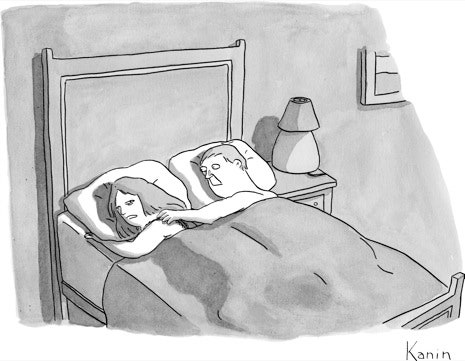
“I’m too tired to have sex but awake enough to argue about it for the next five hours.”
Link copied
Gaiman got his start as a journalist-for-hire, in England. He didn’t go to college. His first book was a Duran Duran biography he finished in three months, using a clip file from the BBC; next, he wrote a biography of Douglas Adams, in the style of Douglas Adams. Gaiman says that, especially in the early stages of his career, “I was very, very good at taking a voice that already existed and just parodying it.” He describes his short piece “We Can Get Them for You Wholesale” as him doing John Collier. “A Study in Emerald” is his version of Sherlock Holmes, by way of H. P. Lovecraft. The writer Gene Wolfe says that “Sunbird,” Gaiman’s story about an epicurean club that eats the mythical phoenix, “is so much in the style of R. A. Lafferty it’s almost as if Lafferty were dictating it from Heaven.” Gaiman still writes on demand, composing for anthologies (the living-statue story was an assignment), birthdays, and holidays. Now that he is widely read, he is apt to publish even the most ephemeral of these offerings, often between hard covers and with lavish illustrations. Last spring, he released “Blueberry Girl,” a bit of doggerel written for his friend Tori Amos when she was expecting her first child. (“Help her to help herself, help her to stand, / help her to lose and to find. / Teach her we’re only as big as our dreams. / Show her that fortune is blind.”) It spent five weeks on the best-seller list for children’s picture books.
The first time Gaiman recognized his own voice was in “Violent Cases,” a graphic novel, with art work by Dave McKean, that was published when he was twenty-six. The story is narrated in the first person by a character who looks, in McKean’s illustrations, exactly as Gaiman did at the time: mullety dark hair, black T-shirt, cigarette streaming smoke up toward his face, dark aviator glasses on indoors. The narrator recalls an episode from his childhood in which his father yanked his arm out of its socket trying to pull him up the stairs to bed. “Even now, my father is taller than I am—and back then he seemed huge,” the narrator says. “When I read stories of giants feefifofumming their way through rocky castles, the ground echoing to their steps, sniffing for the blood of an Englishman in the way that only giants could—the giants always looked like my father.”
In this world, the adults are unfathomable and contradictory; they smell like strangers when they leave the house, and come home drunk and arguing in whispers. “The stuff that happened in the beginning of ‘Violent Cases’ happened to me,” Gaiman says. “The building blocks were either true or fictional lies, which feel like they’re true. I thought, I’m going to tell it in my voice and use actual things that happened and talk about what it is to be three and be a child who has no power. It’s a children’s book for adults.”
Gaiman was born in Portchester, in Hampshire County. His family is Jewish, of Polish descent on his father’s side. As a child, he was bookish and broody; for his tenth birthday, he asked for a shed and got a kit of pine boards, which his parents assembled at the bottom of the garden. It was where he read: the Narnia books; Roger Lancelyn Green; a neighbor’s father’s “Dracula”; Chesterton, borrowed from the library. Instead of studying for his bar mitzvah, he persuaded his instructor to teach him Bible stories—the Behemoth, the Leviathan—and the secret teachings, about Lilith and the Lilim, which he used in “The Sandman.” To his father’s dismay, he spent his bar-mitzvah money on American comics—a good investment, as he sees it now.
The pivotal fact of Gaiman’s childhood is one that appears nowhere in his fiction and is periodically removed from his Wikipedia page by the site’s editors. When he was five, his family moved to East Grinstead, the center of English Scientology, where his parents began taking Dianetics classes. His father, a real-estate developer, and his mother, a pharmacist, founded a vitamin shop, G & G Foods, which is still operational. (According to its Web site, it supplies the Human Detoxification Programme, a course of vitamins, supplements, and other alleged purification techniques, which Scientology offers at disaster sites like Chernobyl and Ground Zero.) In the seventies, his father, who died last year, began working in Scientology’s public-relations wing and over time rose high in the organization. Gaiman has two younger sisters, both still active in Scientology; one of them works for the church in Los Angeles, and the other helps run the family businesses.
At times, Scientology proved awkward for the Gaiman children. According to Lizzy Calcioli, the sister who stayed in England, “Most of our social activities were involved with Scientology or our Jewish family. It would get very confusing when people would ask my religion as a kid. I’d say, ‘I’m a Jewish Scientologist.’ ” Gaiman says that he was blocked from entering a boys’ school because of his father’s position and had to remain at the school he’d been attending, the only boy left in a classroom full of girls. These days, Gaiman tends to avoid questions about his faith, but says he is not a Scientologist. Like Judaism, Scientology is the religion of his family, and he feels some solidarity with them. “I will stand with groups when I feel like they’re being properly persecuted,” he told me.
Having been brought up in two traditions, Gaiman is flexible in his devotions. “I’m terribly good at believing things, but I’m
really good at believing things when I need them,” he said. “Which in my case tends to be if I’m writing about them.” If he had not been a writer, he says, he would have wanted to design religions. “I’d have a little shop, and people would phone up or come into the shop and they’d say, ‘I’d like a religion,’ ” he said. “And I’d say, ‘Cool, O.K. Where do you stand on guilt, and how do you want to fund it? And would you like sort of a belief in the universe as a huge beneficent organ? Or would you like something more complex?’ And they’d say, ‘Oh, we’d like God to be really big on guilt.’ And I’d say, ‘O.K., how does Wednesday sound to you as a sacred day?’ ”
Writing comics afforded Gaiman his great opportunity to invent a cosmology. He approached the work strategically. In the early eighties, he started going to fantasy conventions as a journalist and interviewing authors he admired. At one such event, he met Alan Moore, who, through “Swamp Thing,” was transforming the comic book into something literary, psychological, and self-aware. He asked Moore to show him how to write a script; they sat down and Moore sketched it out in a notebook: page one, panel one, FX for sound effects, and so on. Moore’s style shaped Gaiman’s early work; his scripts were fully realized texts, dense with visual information. Gaiman says that an Alan Moore script for a twenty-four-page comic would be about a hundred pages, his own would run to fifty pages, and most other writers’ would be half that.
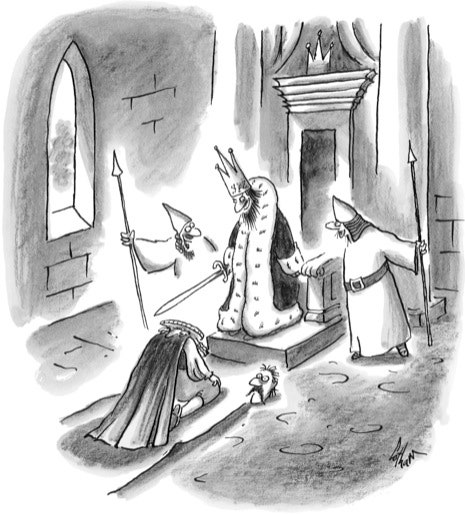
“I thought he was about to be knighted, too, didn’t you?”
Link copied
With Moore’s encouragement, Gaiman sent a sample script to Karen Berger, Moore’s editor at DC Comics; it was called “Jack in the Green,” and used English folklore to tell a Swamp Thing story. Berger didn’t publish it, but she eventually hired Gaiman to write a series based on an archival DC character named the Sandman. In the original nineteen-thirties incarnation, the Sandman had worn a green zoot suit and a gas mask, and killed villains with a gas gun. Gaiman’s hero was different: remote and troubled, ironic and proud, with an archaic vocabulary and a head of hair like a blot of fountain-pen ink. His power rests in storytelling; he travels through human dreams. With his siblings Destiny, Destruction, Despair, Desire, Delirium, and Death, he is one of the Endless, presiding over the universe, but is as flawed and petty as any Greek god.
The first issue of Gaiman’s “Sandman” appeared in 1988. He gave the series a loose, intuitive structure; dream logic prevailed. This allowed him to tell whatever stories he wanted to, about the kinds of people he knew: pre-operative transsexuals, dysfunctional families, mixed-race couples, spurned lovers, addicts, and young adults with tattoos and brightly colored hair. “He’s got incredible storytelling drive,” the novelist Michael Chabon, who has written extensively about comics, says. “The stories just foliate off each other, and mythology and folklore are so confidently and freely appropriated, with such chutzpah.”
The whole is a chaotic collage, composed at the dizzying pace of one issue a month—a rate, Gaiman says, that forced him to access and transcribe his unconscious thoughts without much analysis. Many of the episodes reveal a vexed relationship to the idea of authorship. In “Calliope,” Richard Madoc, a blocked writer, makes a sex slave of the Muse. After he becomes rich and famous for his new work, Dream punishes him with a never-ending stream of ideas: “A man who falls in love with a paper doll. . . . An old man in Sunderland who owned the universe, and who kept it in a jam-jar in the dusty cupboard under his stairs. . . . A sestina about silence using the key words dark, ragged, never, screaming, fire, kiss.” A group of writers who are fans of Gaiman’s work have discussed writing their own versions of Madoc’s premises and assembling them in an anthology.
“ ‘Sandman’ is for that in-between era of reader who is figuring out his or her own beliefs about life,” Charles Brownstein, the executive director of the Comic Book Legal Defense Fund, says. “Neil came up with a well-realized smorgasbord of potential identities and good allegories for how one chooses the identity one chooses as an adult.” The most widely emulated of the Endless is Death, Dream’s older sister, a slinky, flat-chested goth who is sympathetic to women readers in a way that the pinup-shaped women of superhero comics could never be. When she first appears, in the eighth installment, she finds Dream in Washington Square Park. Having escaped some captors, tracked down the emblems of his office (a ruby, a helmet, and a pouch of sand), and restored his kingdom, he’s feeling aimless and depressed. Death sets him straight. “You are utterly the stupidest, most self-centered, appallingest excuse for an anthropomorphic personification on this or any other plane!” she screams. “Feeling all sorry for yourself because your little game is over, and you haven’t got the—the balls to go and find a new one!”
“Sandman,” Gaiman says, is sexually transmitted. “Guys who wanted their girlfriends to read comics would give them ‘Sandman.’ They’d break up, and the girl would take the ‘Sandman’s and infect the next guy. It grew on a vector.” According to Berger, it was the first modern comic to attract a large female readership. “Young women dressed in black and black eyeliner would walk into the comic store and pick up ‘Sandman’ and just walk out,” she said. “You look around a room where Neil is, and half of the fans are women, if not more.” The success of “Sandman” outside the typical comic-book demographic helped Berger form Vertigo, an imprint at DC devoted to graphic novels and edgier, more literary fare. It also allowed Gaiman to negotiate for the right to end “Sandman” where he wanted to, without DC hiring another writer to replace him, which was standard practice at the time.
In 1991, an issue of “Sandman” became the first comic to win the World Fantasy Award for best short story. The awards ceremony was held in Tucson. After winning, Gaiman went to a party in the desert to celebrate, and happened to see a shooting star. Watching it fall, he says, “I just did that thing where you’re following a chain of thought, and you go, That looked like it was really near. What if I went and it wasn’t a meteorite but it was actually like a big diamond or something? Wouldn’t that be cool? And I thought, What if it was a person? And then suddenly it was like a little chain of dominoes.” He went to Charles Vess, the artist who had illustrated the award-winning issue of “Sandman,” and told him the idea. That became “Stardust,” a nineteenth-century-style fairy tale that was first a four-part miniseries for Vertigo, with illustrations by Vess, and then a novel for William Morrow, and finally—after the model Claudia Schiffer read it and implored her husband, the director Matthew Vaughn, to make it—a movie starring Claire Danes and Michelle Pfeiffer.
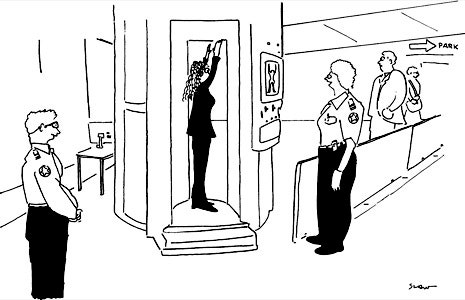
“It’s a boy!”
Link copied
Stephin Merritt says that Gaiman “wants to make bigger and bigger productions until finally they’re big enough to live in.” Shaped by the fanciful side of his imagination—the part of him that can refer to things as “derelicty”—his surroundings at home almost qualify. For nearly twenty years, he has lived in a rural outpost in Wisconsin. His house is a brick Queen Anne from the eighteen-eighties, with a shingled turret and a porch; a shaggy creeper covers its back half like a shrugged-off winter coat. Inside, the house is divided into Dog and Cat, the latter the domain of five cats, including a white one named Princess and a blind one that lives in the attic. Dog belongs to an eighty-pound white German shepherd that Gaiman picked up on the side of the road and named Cabal, after King Arthur’s hound. There is a garden, full of bearded irises and wild strawberries, and, near a stream in the woods, a clearing with four beehives painted lavender, yellow, green, and red. At the bottom of the garden is a wooden gazebo, where Gaiman goes to read and write. The handyman who helps maintain the property is burly, and missing several teeth; he goes by the name Woodsman Hans. (This is also his Twitter handle; everyone in Gaiman’s entourage, including the person who helps him tend the bees, tweets.) Gaiman’s assistant Lorraine—purple hair extensions, the fiddle player in a Celtic band—responds to Quiche. One room of the house is furnished completely with sofas and cushions in the shape of sushi rolls. There is elderflower cordial in the fridge.
While still in England, Gaiman met an American woman named Mary McGrath, who was studying Scientology in East Grinstead and living in a house owned by his father. They had a son, Mike, in 1983 and got married two years later. Shortly after that, they had a daughter, whom they named Holly, after the transvestite in the Lou Reed song. In the early nineties, the family moved to the United States, in part because Gaiman was being paid by DC Comics in dollars, which were weak against the pound. Mary’s family lived in Minneapolis; the plan was to be within driving distance of them but, as Gaiman puts it, not so close that the in-laws didn’t have to call before visiting. Maddy, their third child, was born there. Gaiman and his wife grew estranged and, after a long separation, divorced in 2008. Mary lives in a cottage on Gaiman’s property, and Maddy, who is in tenth grade, splits her time between the two households.
In town, Gaiman is more or less anonymous. The place has an aura of eerie, orderly Americana: an old Masonic hall, a bandstand, a painted roadside shack selling ice cream and cheese curd. Gaiman mined it for “American Gods,” a novel that imagines immigrants to the United States bringing the deities of their home countries with them, and then, seduced by modern life, slowly abandoning them. He describes the book as a response to the culture shock he felt upon moving to the United States—he was suddenly expected to eat at McDonald’s and root for a football team. “I got fascinated by the things that I thought were really weird that nobody else except me seemed to think were weird,” he said. For instance, he was confounded by the local custom of driving a jalopy onto the lake in the dead of winter and placing bets on which day the ice would melt enough for the car to sink through. In the novel, he put a corpse in the trunk, a sacrificial victim to a Bronze Age god who rules the town.
Comics, science fiction, and fantasy conventions are nowadays something of a hardship for Gaiman—“like being a maggoty log at a woodpecker convention,” he says. A few years ago, he was at a convention with Angelina Jolie, who played Grendel’s mother in the movie “Beowulf,” for which Gaiman co-wrote the screenplay. “When I try to explain that I attracted more attention than she did, people say, ‘Oh, ho, he’s being funny.’ I’m not.” At Worldcon, the international science-fiction convention, where he was the guest of honor in August, people walked around wearing pins that read “Neil Gaiman! Squeeeeeee!”—an expression of hysterical enthusiasm. One woman, when he asked to borrow her program for a moment so that he could see where he needed to be next, crowed, “He’s getting eye tracks all over my program!”
Gaiman was scheduled to attend a “sushi party” one evening in the teen lounge, a duplex suite on a high floor of the convention hotel. On the door was a sign that read “Under 30, Over 12.” He climbed the stairs to a loft, where a dozen young people sat around a table beside a buffet of eel-and-avocado rolls and a thermos of miso soup. They cheered when they saw him.
“Do you lot have names?” he said brightly.
“Nooooooo!” they called, in unison.
“How many coats like that do you have?” a small girl with blue and green streaks in her hair asked.
“I’m pretty much always wearing something black or coaty or jackety,” Gaiman said. She beamed. Another girl, wearing a pink corset and with a camera around her neck, asked Gaiman if he read his reviews. He said, “I always read reviews right at the beginning, and after a while I stop reading reviews and start counting reviews.” At the edge of the room, a slim young woman in a purple dress said, “I don’t do hard-core on authors, ’cause they’re just people.” No one paid any attention to her.
The following afternoon, Gaiman reported to the nursery, where there was a long crafts table covered with bins of pompoms, googly eyes, and crayons. Children dressed as princesses and Harry Potter characters were stationed there, scribbling. The goal was to create something inspired by Gaiman’s picture book “Crazy Hair.” (“Twisting tangling / Trails and loops, / Treasure chests / And pirate sloops, / These await / The ones who dare / Navigate my crazy hair.”) Gaiman stood at one end of the table.
“I wrote ‘Coraline,’ ” he said.
“Yay,” a few of the children said, mechanically.
Gaiman ventured that some of them might have seen the movie and been frightened.
A tiny five-year-old in a cape looked up. “I was scared by it,” he said. “I was really scared.”
“My cousin, who’s one, she was screaming,” another child said.
Gaiman changed the subject. “This is a story I wrote because sometimes my hair gets a little bit weird,” he said, and read them “Crazy Hair.” They listened silently. “I’m Neil Gaiman,” he said when he had finished. “I’m the author.” The children resumed coloring, and Gaiman left, to participate in a panel on his own roots as a fan.

“Excuse me, but on weekdays at 4 A.M. my wife and I are not so much into the pop music.”
Link copied
On the third day, mushroom pale, with violet pouches under his eyes, Gaiman arrived at an auditorium for a panel. He was wearing a T-shirt printed with a passage from “American Gods,” which he says is the most direct expression of his religious beliefs: “I can believe things that are true and I can believe things that aren’t true and I can believe things where nobody knows if they’re true or not. I can believe in Santa Claus and the Easter Bunny and Marilyn Monroe and the Beatles and Elvis and Mister Ed. . . . I believe that the greatest poets of the last century were Edith Sitwell and Don Marquis, that jade is dried dragon sperm, and that thousands of years ago in a former life I was a one-armed Siberian shaman.” As he was hurrying to the stage, late, a fan approached and asked if he’d like to hear an L. Ron Hubbard joke, but Gaiman turned him down.
Gaiman began thinking about “The Graveyard Book” in East Grinstead, when he and Mary were first married. Mike was a toddler, and liked to ride a tricycle, but their apartment building was narrow and full of staircases, so Gaiman would take him to the graveyard across the street, where he could ride freely. As he sat there, watching his son cheerfully pedalling among the headstones, it occurred to him to write a book about a child reared by ghosts. After he finished the book, several years ago, Gaiman made a nine-city reading tour, and at each stop read a chapter (there are eight, but one is double length). The readings were videotaped, and Gaiman posted them to his blog. Every time the book dipped on the best-seller list, he tweeted a reminder to his followers that they could hear him read “The Graveyard Book” for free online, and, he says, sales of the print edition spiked.
Last spring, Gaiman announced a contest for the best “Graveyard Book”-themed Halloween party at an independent bookstore. The prize would be a visit from him. He spent the fall travelling: to Edinburgh; to the Isle of Skye; to London, to make the silent film “Statuesque,” starring Amanda Palmer as a lovelorn living statue; and to China, to research a nonfiction book about the seventh-century monk who went from China to India and brought back the foundational Buddhist texts. In December, Gaiman flew to Decatur, Georgia, the location of Little Shop of Stories, which he had picked as a winner of the contest. In tribute to “The Graveyard Book,” the store had transformed its basement into a crypt and led the children in a
danse macabre, beating out a store in Larchmont, New York, that had brought in a live white pony, in honor of the preferred conveyance of the novel’s death figure.
It was a foggy day, with intermittent rain, and people started lining up before noon outside Agnes Scott College, which was hosting the event. The reading started at six. On the way there, the head of the Decatur book festival, who was to introduce Gaiman, got him to sign his dashboard. Gaiman walked onstage and complimented the audience on their fog. He told them he was going to read from his newest work, a children’s story called “Odd and the Frost Giants,” the plot of which revolves around Odin, Thor, and Loki. He asked if anyone had a copy. A boy with curly red hair and glasses sprang up and offered his: Max Calderon, aged twelve, the great-grandson of the science-fiction writer Robert Heinlein.
Advertisement
There were a thousand people in the audience. Gaiman told them he would stay as long as it took to sign for everyone. “I will sign until my hand falls off!” he said, like a political martyr rallying a crowd. They cheered wildly. It was a school night, so the children lined up first. Lucy Andrew, a fifth grader with a blond bob, was jumping by the time she found herself before Gaiman. “Squeeeee!” she said. “It’s really Neil Gaiman!” She told him “Coraline” was her favorite book in the whole world, and walked away saying, “Oh, my God, it’s Neil Gaiman.” Her friend Caroline wore a pair of oversized buttons, strung on clear fishing line, over her eyes. Caroline’s twelve-year-old sister, Anna, announced that she was reading, for the second time, “Good Omens,” a funny novel about the Apocalypse that Gaiman wrote with the British fantasist Terry Pratchett. A shy four-year-old in sparkly silver shoes approached Gaiman and showed him a picture of herself from Halloween, dressed up as Coraline. Her mother, also a Gaiman fan, said her daughter had seen the movie and wasn’t the least bit scared. Outside, there was a crack of thunder, and it started to pour. ♦
Published in the print edition of the
January 25, 2010, issue.
 Dana Goodyear
Dana Goodyear is a staff writer at The New Yorker and the host of the podcast “Lost Hills.”

